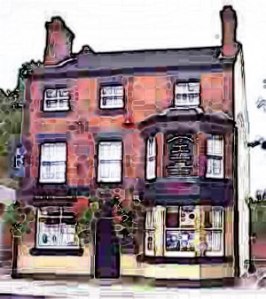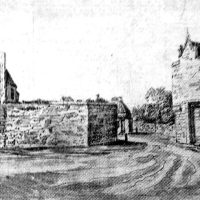 Until 1815 the place of execution in Lincoln was at the corner of Burton Road and Westgate, where the convenience store and adjoining cottages now stand, and was known as Hangman’s Ditch.
Until 1815 the place of execution in Lincoln was at the corner of Burton Road and Westgate, where the convenience store and adjoining cottages now stand, and was known as Hangman’s Ditch.
The last person hanged on the old gallows was William Ward, for shopbreaking at Mareham, on 1st April 1814. In those days prisoners sentenced to be hanged were often executed in batches, usually for very trivial offences. On 18th March 1785 nine prisoners were hanged at one time, three for highway robbery, two for sheep stealing, two for cattle stealing, one for horse stealing and one for housebreaking. It was reported that a crowd of 20,000 watched the executions.
In April 1747 Mary Johnson was burned at the stake for the murder of her husband, but prior to her burning she was strangled. The same punishment was meted out to another woman for the murder of her husband in 1722.
From 1815 to the passing of the Act abolishing public executions in 1868, the tower in the north east corner of the castle, known as Cobb Hall, was the place where those sentenced to death were hanged. The gallows was erected on the lead flat roof at the top of the tower.

The Strugglers Inn
Hanging was once a crude affair, those being hung died of strangulation which meant that they took a long time to die, they struggled on the gallows, hence the name of the inn at the north west corner of the castle: The Strugglers.
The Strugglers is said to be haunted by a lurcher that belonged to William Clark who was executed on 26th March 1877 for the murder of Henry Walker, a gamekeeper.
William Frederick Horry was convicted of murdering his wife, Jane, and was sentenced to die on the gallows on 1st April 1872. This execution was significant because it was the first one carried out by the Horncastle cobbler, William Marwood. Marwood had developed a method of hanging called the “long drop”, this method ensured that the prisoners neck was broken instantly at the end of the drop.
Marwood was appointed the official Crown Executioner in 1874 and carried out 178 executions in his 9 year career, his last hanging was in September 1883 when he hung the Irish Invincibles, five Irish nationalists who murdered Lord Frederick Cavendish, the Chief Secretary for Ireland, and Thomas Henry Burke, the Permanent Undersecretary for Ireland, with surgical knives in Dublin’s Phoenix Park.
















As I understand it, the Strugglers is a modern name for the pub and it was known by another name in the 19th century.
The pub was not built when the last person was hung on the public gallows. The only known picture I could find of the gallows is from a painting of the Cathedral viewed from somewhere along the Burton cliff. The gallows os shown as a single cross beam on two supports.
Many thanks for your comment. The first record I can find of the ‘Strugglers’ is in an 1891 Directory of Lincoln, but there may have been a beerhouse on the site prior to the ‘Strugglers’. I have seen the picture you refer to, was it one of the Grimm drawings from 1784?
Yes Phil… you kindly reproduced it for me some time ago… These gallows belonged to the county from where the felons were escorted to from the prison in the castle. The city of Lincoln had its own court, prison and gallows, the latter being sited on Canwick Road near the junction with Heighington Road. This location was an ancient site that had been in use in the 13th century…
Yes, you’re right. The Lincoln prisoners were held in the prison next to the Stonebow until the building of the Sessions House in the early 19th century. In 1205 the murderer of William de Bramfield, a subdean at Lincoln Cathedral, is said to have been hanged on the gallows on Canwick Hill – see “Murder In The Cathedral” blogpost.